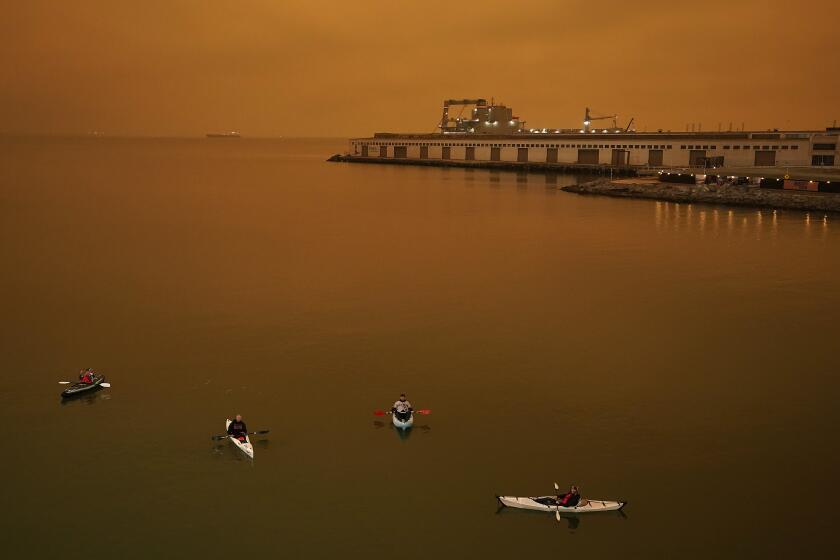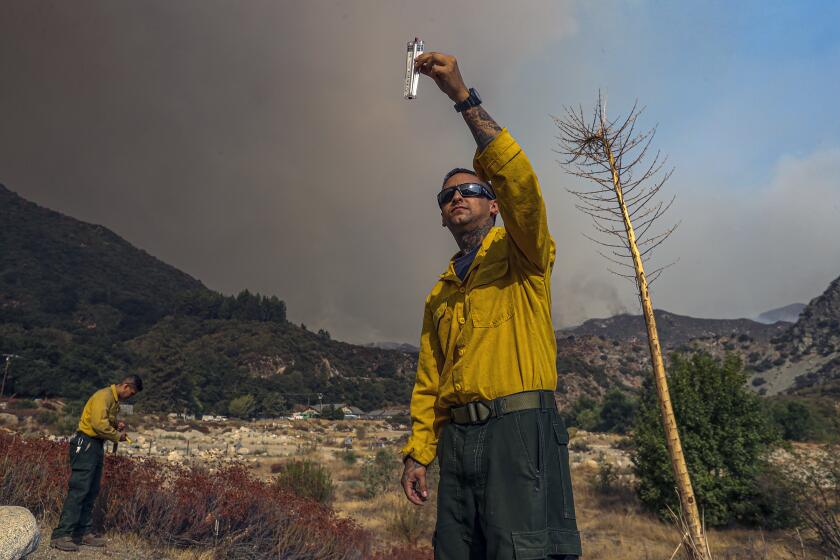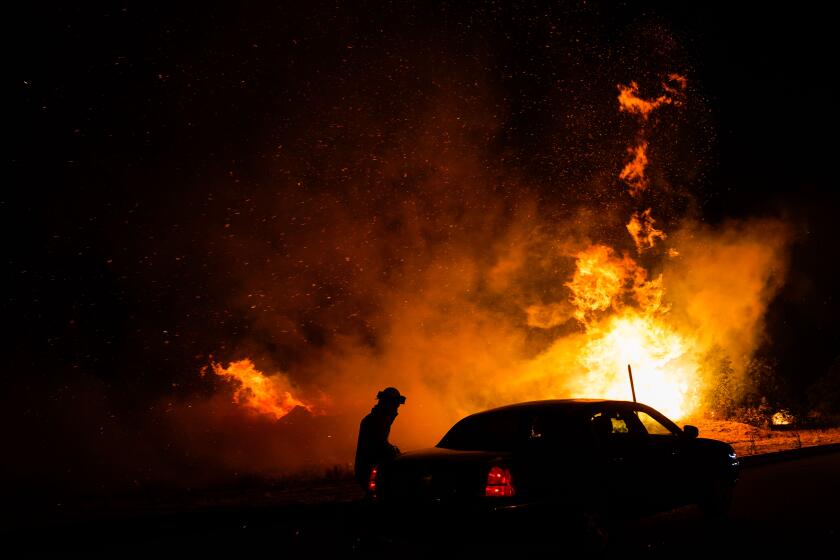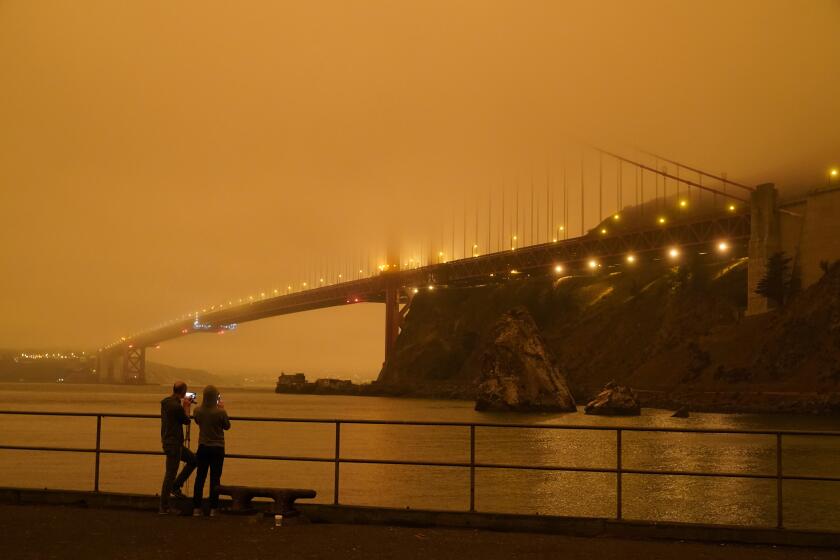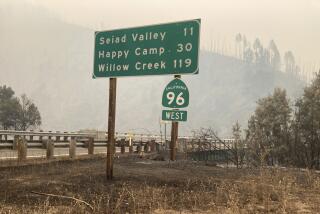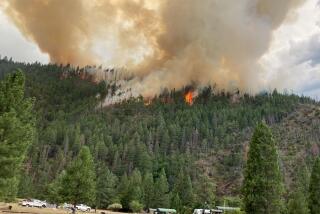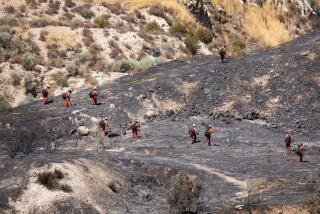3 dead as Northern California fires spread rapidly, burning through small town
Wildfires of historic magnitude have led to daring escapes and wrenching devastation.
California’s already record-setting fire season worsened considerably Wednesday as more than two dozen fires forced thousands of residents from their homes amid growing alarm about a new monster blaze that rapidly consumed more than 250,000 acres around Oroville and killed at least three people.
Butte County Sheriff Kory Honea announced the deaths Wednesday evening. He did not provide details about where the victims died but said the bodies were found in areas where the Bear fire, part of the massive North Complex, had swept through.
For the record:
10:50 p.m. Sept. 9, 2020A previous version of this story misspelled the last name of Creek fire response spokesman Chris Vestal as Vestel.
The remains of two people were found at one location; the third body was found elsewhere.
Honea said his agency and others had desperately tried over the last 24 hours to alert residents in mountain communities that the fire was headed in their direction and that they needed to evacuate.
In announcing the deaths, Honea said he was reminded of how, two years earlier, he had to disclose the toll of the Camp fire, which killed 85 people and is the deadliest and most destructive wildfire in California history.
“We cannot underestimate what they can do to the community and what they can do to the people we love,” he said.
Twenty-eight major wildfires burning statewide have prompted more than 64,000 people to evacuate, said Daniel Berlant, a spokesman for the California Department of Forestry and Fire Protection.
The skies around the Bay Area and other parts of Northern California took on an eerie glow as smoke from several fires enveloped the region.
Some 20,000 residents in Plumas, Butte and Yuba counties have been forced to flee from the North Complex fires, which exploded in size as “topography, high winds and dry fuels aligned to produce unprecedented fire behavior,” officials said Wednesday morning.
Overnight, the complex — which includes the Bear fire — spread at a rate of about 2,000 acres an hour, according to federal firefighters handling the incident.
By Wednesday morning, it had consumed an additional 80,000 acres — bringing its total size to more than 254,000 acres, stunning fire officials with its speed and ferocity and extending its potential threat all the way to the towns of Paradise and Concow, which were devastated in the 2018 Camp fire.
Photos showed devastation in the tiny Butte County hamlet of Berry Creek, where many homes and other structures were destroyed by flames. Officials said they don’t know the extent of the destruction in the town, which is north of the Oroville Dam. Some witnesses said many buildings were lost.
Both towns are now under evacuation warnings, while evacuation orders have been issued for other areas around Lake Oroville.
Jay Kurth, incident commander for the U.S. Forest Service, said the agency was still working Wednesday morning to “figure out where the fire footprint really is” because of the extreme overnight activity.
Kurth added that weather conditions had improved with daybreak, including a softening of the winds, but he said the situation remained volatile.
“Overall, the combination of hot, very dry and windy weather is a culmination of very critical conditions for the state,” Brent Wachter, a predictive services meteorologist with the Forest Service, said in a video statement Wednesday.
Nearby, 3,000 residents were evacuated from the community of Loma Rica in Yuba County on Wednesday as the Willow fire grew to 1,000 acres, according to Cal Fire.
Pacific Gas & Electric Co. also worked Wednesday to restore service to numerous communities whose power had been shut off in hopes of avoiding new fires potentially being sparked by downed power lines. As of just after 11 a.m., power had been restored to 30,000 customers, the utility said.
In light of the unprecedented fire conditions, the Forest Service announced that all national forests in California would be temporarily closed starting at 5 p.m. Wednesday.
The agency had already closed eight of the state’s national forests Monday but moved to shut the remaining 10 — Eldorado, Klamath, Lassen, Mendocino, Modoc, Six Rivers, Plumas, Shasta-Trinity, Tahoe and the Lake Tahoe Basin Management Unit — “to protect the public and our firefighters,” Regional Forester Randy Moore said.
“We will keep [closures] in place until conditions improve and we are confident that national forest visitors can recreate safely,” he added in a statement. “I ask all Californians and visitors to take these closures and evacuations seriously for their own safety and to allow our firefighters to focus on the mission of safely suppressing these fires.”
California expands its forest closures because of extreme fire risk.
With the potential for more strong winds in the forecast and red flag warnings in place for much of the state through Wednesday evening, fire officials warned that the challenging conditions present a risk not only of swelling existing fires — some of which already rank among the largest in California’s history — but also of giving a foothold to new ones.
“Yesterday and overnight, firefighters had a significant battle on their hands as winds whipped a number of fires, allowing significant growth and extreme fire behavior, not only for a number of new fires, but also in some of the major fires that have been burning,” Berlant said.
The Dolan fire burning in Monterey County, for instance, has doubled in size this week — a frenetic growth rate one official attributed to the combination of strong winds, punishing temperatures and steep, rugged terrain.

That fire had burned through more than 93,000 acres and was 20% contained as of Wednesday morning.
“For wildland firefighters, we’ve been in an all-hands-on-deck situation for weeks now,” said Jacob Welsh, public information officer for Pacific Northwest Team 2, pointing to the number of significant fires burning up and down the West Coast.
He added: “I’ve never seen anything like this in 20 years.”
Forecasters said winds remained relatively calm in the vicinity of the Bobcat fire, burning in the San Gabriel Mountains above Monrovia, and near the Creek fire in the Sierra foothills.
Fourteen firefighters defending a ranger station in Los Padres National Forest had to deploy a shelter. Three of them were hospitalized.
“We didn’t have much wind overnight,” Mike Wofford, a meteorologist with the National Weather Service in Oxnard, said of the Bobcat fire.
As of Wednesday morning, Wofford said, winds were “generally under 15 mph,” though “we could get some gusts, 20 to 30 mph, later this morning around the fire area.”

“We’re getting some stronger winds now, but they’re mostly on the ridges higher up above where the fire is currently,” he said about 7:30 a.m.
Though extreme winds have howled in some parts of the state, Wofford said, “the [Bobcat] fire area was always a little bit questionable given its location — it wasn’t in an area that typically gets these strong winds.”
“We’re just fortunate it wasn’t in one of those areas,” he said.
Officials on Tuesday expanded the evacuation warning area for the Bobcat fire — warning residents of Monrovia, Arcadia, Sierra Madre, Bradbury, Altadena, Duarte and Pasadena that they should be prepared to leave quickly should the need arise.
That blaze has charred more than 11,400 acres and is still 0% contained.
Smoke advisories have been extended for most of L.A. County and parts of other counties. An evacuation area has been set up at Santa Anita racetrack.
Regarding the Creek fire, “generally speaking … most locations weren’t that windy the other day,” said Colin McKellar, a weather service meteorologist in Hanford.
“We’re getting kind of lucky in that sense,” he said Wednesday. “The winds aren’t going to be that big of an issue.”
Forecasters also said it appeared that winds could weaken throughout the day.
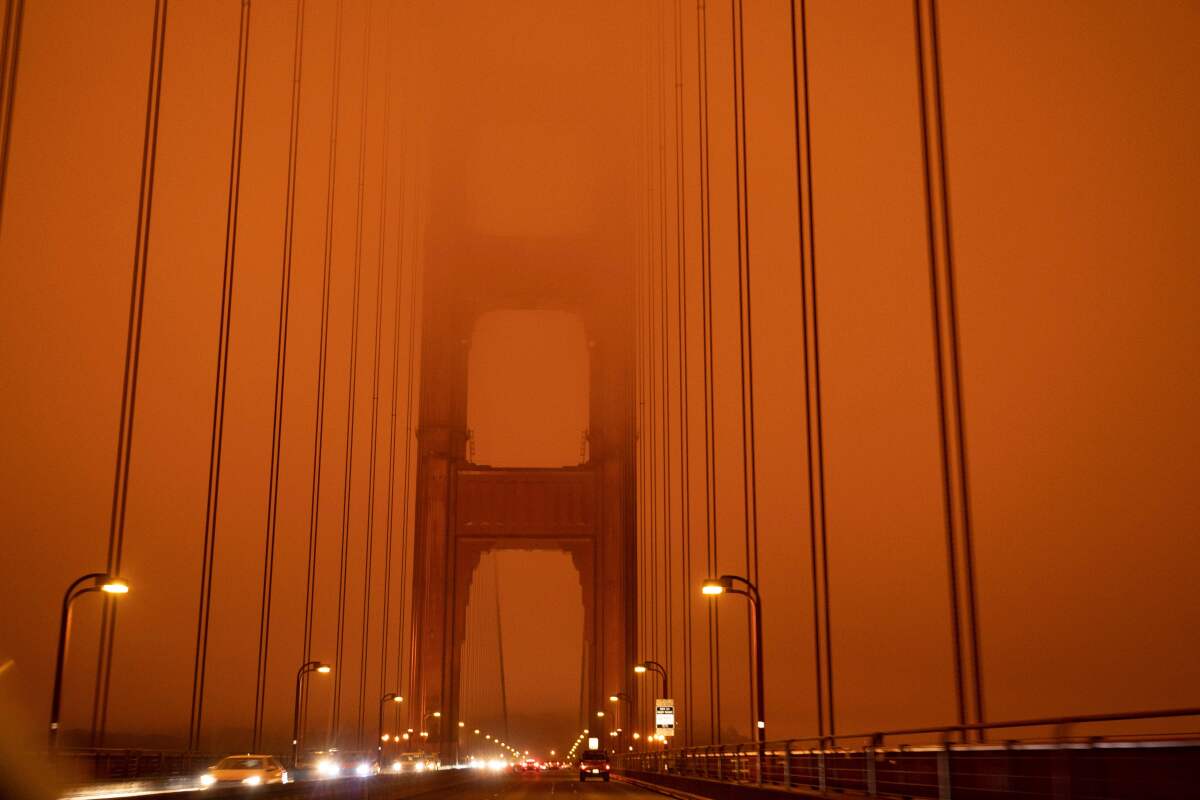
“We’re encouraged that the wind activity appears to be dying down … and the rest of the week looks a little more favorable from a wind perspective and a weather perspective,” Gov. Gavin Newsom said during a briefing Wednesday.
Still, the rash of new fires has been devastating.
The Creek fire alone has burned more than 163,000 acres and destroyed an estimated 360 structures as of Wednesday morning. An additional 5,296 structures are threatened.
On Tuesday, officials issued new evacuation orders covering the Fresno County communities of Tollhouse, Burrough Valley and Cold Springs Rancheria.
They were seeking fresh air, solitude and life away from coronavirus lockdowns. Instead, they got caught in a firestorm, some rescued by helicopter.
The bulk of the firefighting efforts Wednesday were on the Creek fire’s southern flank, closest to foothill towns such as Prather, Auberry and Clovis in the flatland, where winds were light and ash rained down throughout the day.
The forest that surrounds them is filled with up to 2,000 tons of burnable timber per acre, most of it dead and dry from a bark beetle infestation that exploded in the Sierra Nevada during the drought that began in 2012.
Crews are focusing on areas south of the fire, “clearing roads in any communities not evacuated and making sure people can get out if they’re evacuated,” fire spokesman Chris Vestal said.
Relatively scant growth was reported on two other Southern California wildfires.
The El Dorado fire, near Yucaipa, was 11,479 acres and 19% contained as of Wednesday, while the Valley fire, southeast of Alpine in San Diego County near the Mexican border, was 17,565 acres and 11% contained, according to Cal Fire.
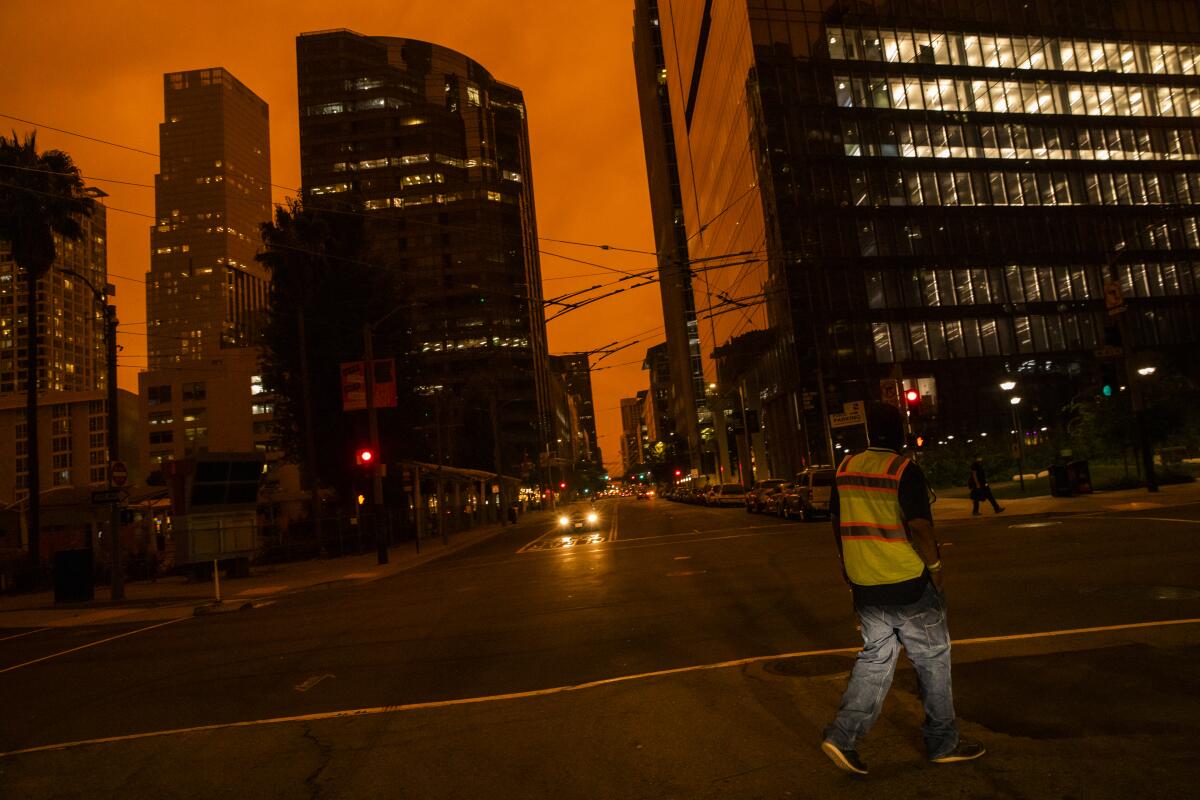
As of Wednesday, more than 14,000 firefighters were contending with 28 major wildfires, according to Cal Fire, and the agency had increased staffing in preparation for critical fire weather in several areas.
So far this year, 7,657 fires statewide have scorched more than 2.5 million combined acres, Berlant said. That’s an increase of more than 2,000% over the number of acres burned by this time last year.
“This year has already been a very destructive fire season, and it is nowhere close to being over,” Berlant said.
Fire activity has been particularly prolific since Aug. 15, which marked the start of a “lightning siege” that unleashed thousands of lightning strikes statewide.
Eight people have died during the weeks-long firestorm, and more than 3,400 structures have been destroyed.
“This is a challenging year,” Newsom said this week. “It’s historic in terms of magnitude, scope and consequence, and it also has required … a deep reservoir of resource.”
The numerous fires also have wreaked havoc on the region’s air quality.
From San Francisco to Yosemite, social media was filled with images of ominous red and orange skies as smoke from a variety of fires blocked the sun.
The National Weather Service said Wednesday morning there was an “unprecedented amount of smoke in the atmosphere as a record number of acres burn across California and the West,” obscuring the marine layer up and down the West Coast.
Satellite imagery posted by the agency showed a blanket of smoke over much of California and extending far out over the Pacific Ocean.
Air quality officials have issued a wildfire smoke advisory for much of Southern California through Wednesday evening, warning that “meteorological conditions will bring smoke and ash into portions of Los Angeles, San Bernardino, Riverside and Orange Counties.”
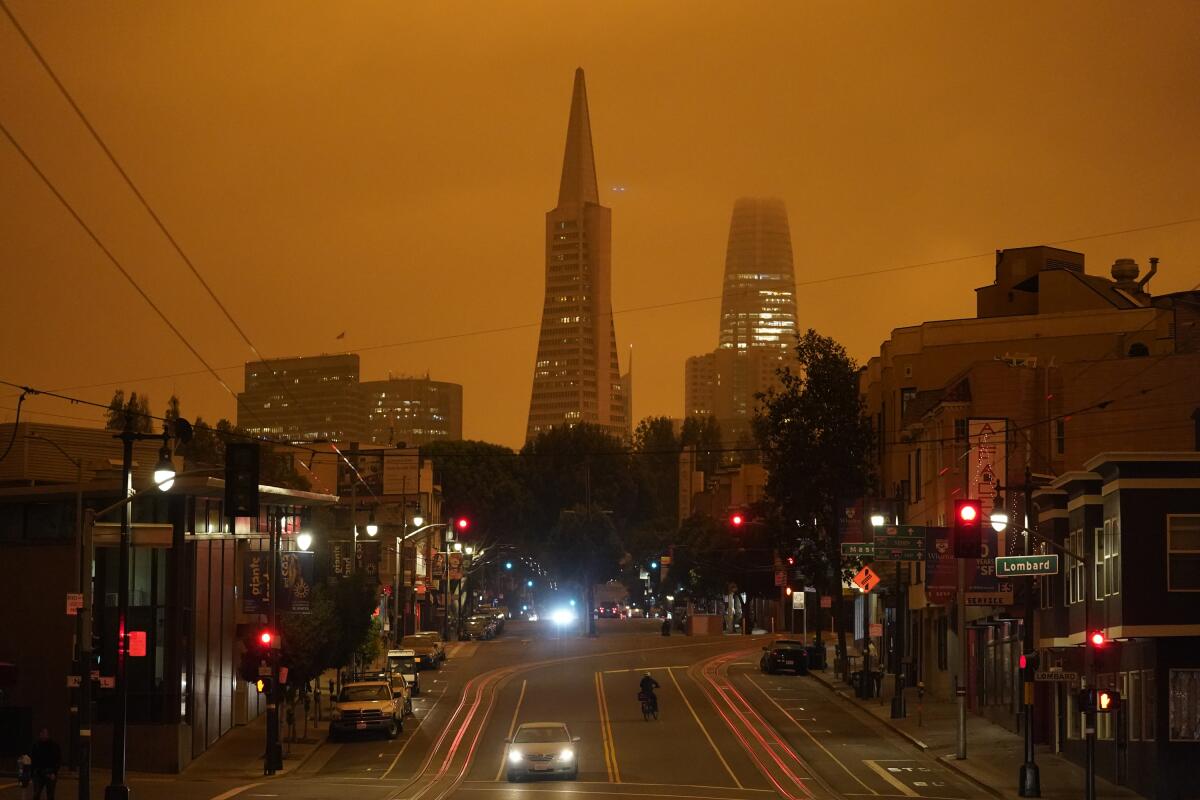
According to the South Coast Air Quality Management District, the worst concentrations of smoke, which contains tiny, lung-damaging pollution particles known as PM2.5, are expected in communities closest to the Bobcat and El Dorado fires — the latter of which is burning near Yucaipa.
The smoke that’s blanketing California’s entire Central Valley and Sierra foothills is also hurting firefighters’ ability to defend against the oncoming flames.
The high-pressure system that’s brought record-breaking heat is also, with few exceptions, keeping smoke from the state’s myriad fires closer to the ground, creating a gray shroud that makes it unsafe for pilots to fly and survey where the fires have been and where they are going, officials said.
“One of the things we’ve seen statewide is with all the smoke, we can’t get a good assessment,” said Vestal, the Creek fire spokesman.
Burning in extremely dry and steep terrain, flames carry the potential to spread their red-hot embers across football-field distances in seconds and miles in minutes — making situational awareness for the crews that battle them paramount.
“It’s hard to see that same vantage point from the ground,” Vestal said. “We get to make some tactical decisions and the … chiefs can then order resources and figure out what exactly it is, where our values at risk are, if there’s any critical infrastructure, anything that needs extra protection. It’s just a lot easier to see it from above and get that full, really comprehensive view of the incident.”
More to Read
Start your day right
Sign up for Essential California for news, features and recommendations from the L.A. Times and beyond in your inbox six days a week.
You may occasionally receive promotional content from the Los Angeles Times.

